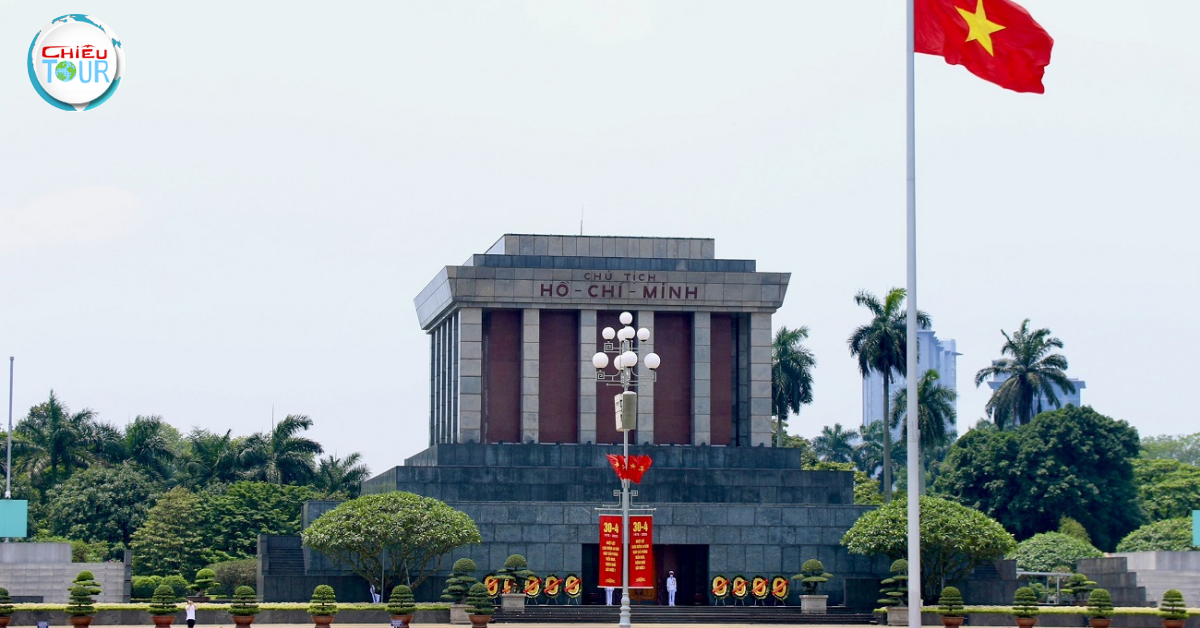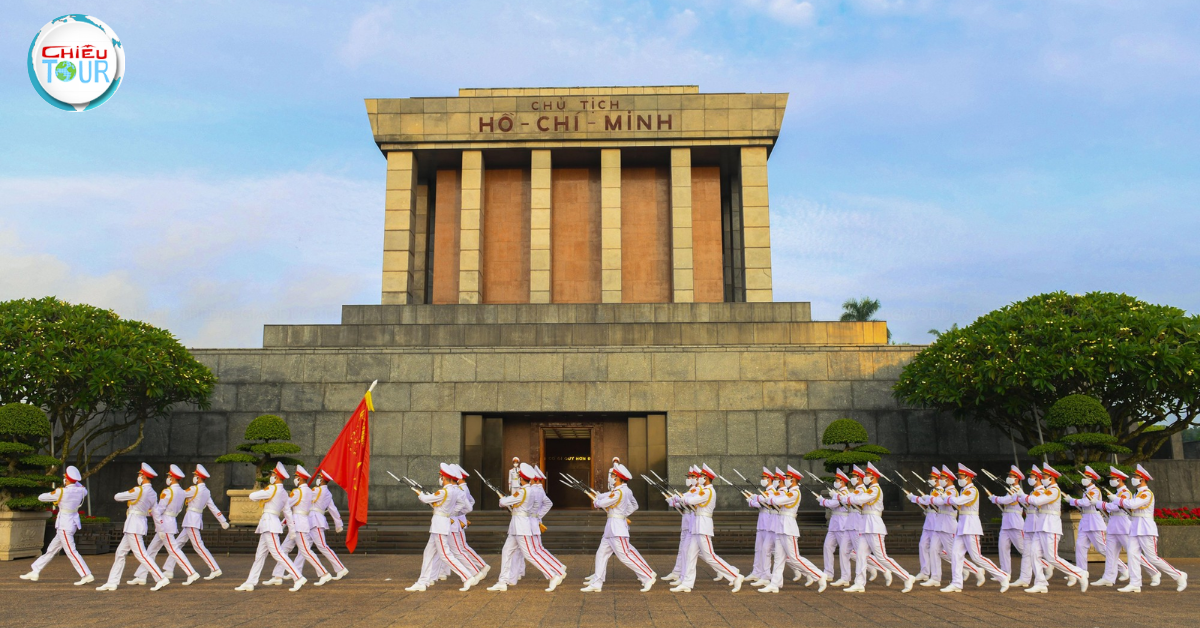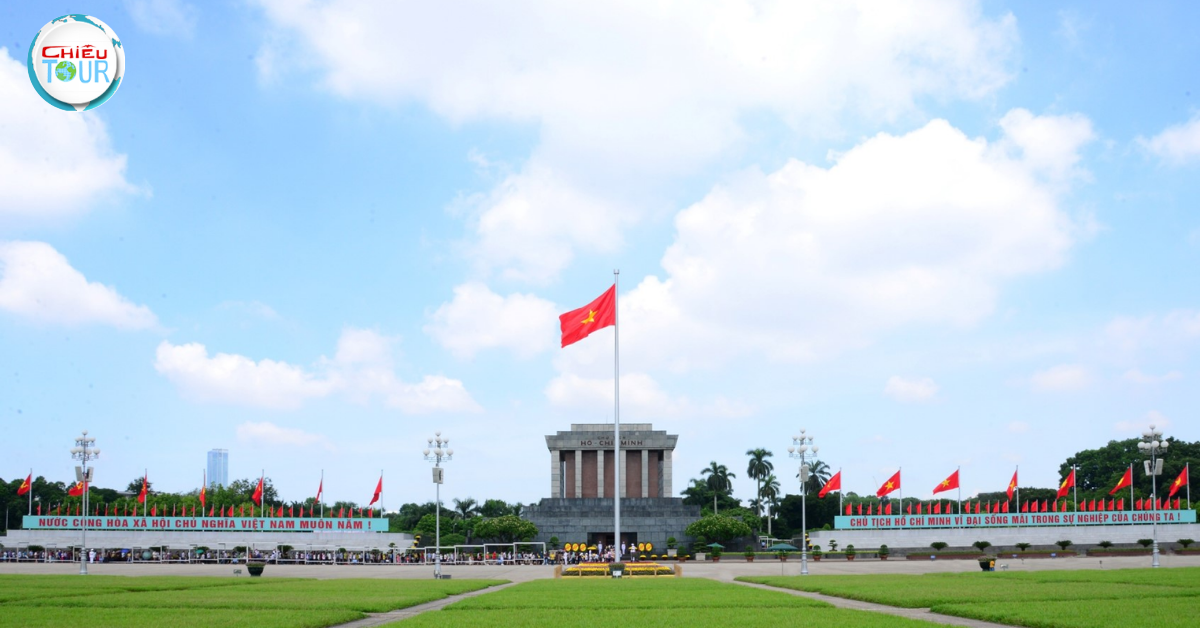Ho Chi Minh Mausoleum - Uncle's Mausoleum
- Author: Admin
- | Travelogue
Introduction to Ho Chi Minh Mausoleum - Uncle Ho's Mausoleum
The Ho Chi Minh Mausoleum is an architectural marvel and a pilgrimage site for those wishing to connect with the legacy of Ho Chi Minh, the founding father of modern Vietnam. This significant landmark was built to honor him after his passing in 1969. The mausoleum not only preserves the physical body of Ho Chi Minh but also embodies his ideals and aspirations for a unified and prosperous Vietnam.
Ho Chi Minh’s impact on Vietnam is immeasurable; he led the country through decades of strife and war to achieve independence and foster a sense of nationalism among its citizens. His mausoleum thus serves both as a memorial to his life and a monument to the sacrifices made by millions of Vietnamese during their fight for freedom and self-determination.
Visiting the Ho Chi Minh Mausoleum - Uncle's Mausoleum offers tourists a unique opportunity to delve deeper into Vietnam's historical narrative while gaining insight into the life and legacy of one of the 20th century's most influential leaders. It invites reflection on the values of sacrifice, determination, and unity that Ho Chi Minh championed throughout his life.

Visiting Ho Chi Minh Mausoleum
Visiting the Ho Chi Minh Mausoleum is a profound experience that requires preparation and respect. Many visitors consider it a rite of passage when visiting Hanoi. Understanding the significance of the site and adhering to guidelines can enhance your visit tremendously.
The mausoleum is located in Ba Dinh Square, a historic area that itself is steeped in significance. It's essential to allocate enough time for your visit, as the experience encompasses various elements beyond merely observing the preserved body of Ho Chi Minh.
Planning Your Visit
Before heading out to the mausoleum, it is wise to check the opening hours and any potential closures, especially during public holidays or significant dates in Vietnamese history. The best time to visit is early morning when crowds are fewer and the atmosphere is serene.
You may want to combine your trip with visits to nearby attractions like the Presidential Palace and Ho Chi Minh's Stilt House for a comprehensive understanding of his life and contributions. Each location tells part of the story of Uncle Ho’s journey, making this area a treasure trove of historical insights.
What to Expect upon Arrival
Upon arrival, you'll be greeted by the imposing sight of the mausoleum, constructed from grey granite. Its architecture reflects Soviet influences, and its design symbolizes both strength and gravitas. As you approach, the silent reverence of other visitors adds to the contemplative ambiance.
Security personnel ensure that decorum is maintained. You will notice signs instructing visitors on how to behave while inside and outside the mausoleum, reinforcing the need for respect in such a solemn environment.
The Experience of Entering the Mausoleum
As you enter the mausoleum, the temperature drops slightly, adding a chill that complements the gravity of the space. The atmosphere is hushed as visitors file past Ho Chi Minh’s embalmed body, which is displayed in a glass case illuminated softly.
This poignant moment allows for personal reflection, encouraging visitors to contemplate Ho Chi Minh’s legacy and the struggles faced by the Vietnamese people. The sight of the leader, dressed in a simple suit, epitomizes humility despite his monumental role in shaping the nation.
Admiring the Architectural and Cultural Masterpieces
The Ho Chi Minh Mausoleum - Uncle's Mausoleum is not solely about honoring a remarkable individual; it also represents a striking example of architectural brilliance. The design integrates traditional Vietnamese elements with Soviet-inspired architecture, creating a visual narrative that tells the story of Vietnam’s complex history.

A Blend of Architectural Styles
The mausoleum's structure is reminiscent of Lenin’s Mausoleum in Moscow, reflecting the communist ties that influenced Ho Chi Minh. However, local materials and cultural motifs are incorporated, creating a unique fusion that reflects Vietnam’s identity.
The surrounding landscape further enhances the mausoleum's beauty, featuring vast gardens filled with trees, flowers, and statues that celebrate Vietnamese culture. These elements contribute to a tranquil yet majestic setting, inviting visitors to pause and appreciate the artistry at work.
Symbolism in the Design
Every aspect of the mausoleum's design carries symbolic significance. The large stone steps leading up to the entrance represent the arduous journey Vietnam has taken toward independence. The grand façade signifies the strength and resolve of the Vietnamese people in the face of adversity.
Inside the mausoleum, the layout encourages a slow, reflective procession, allowing visitors to absorb the weight of history and the values embodied by Ho Chi Minh. The use of dim lighting creates an ethereal quality to the space, enhancing the solemnity of the experience.
Cultural Artifacts and Their Significance
Beyond the mausoleum itself, the adjacent museum provides insights into Ho Chi Minh's life, philosophies, and the broader context of Vietnam's history. Exhibits feature photographs, personal belongings, and gifts from foreign dignitaries, painting a vivid portrait of a man who inspired millions.
As visitors explore the museum, they gain a deeper understanding of Ho Chi Minh's ideals, including his belief in socialism and communal responsibility. The artifacts and displays serve as reminders of the ongoing journey toward achieving these goals in contemporary Vietnam.
Journey to Explore the Mausoleum Complex
The Ho Chi Minh Mausoleum - Uncle's Mausoleum is part of a larger complex that includes several significant sites worth exploring. Each location plays a crucial role in understanding Ho Chi Minh's life and the historical context of Vietnam's revolutionary struggle.

The Ba Dinh Square
Ba Dinh Square, where the mausoleum is located, is historically significant as the site where Ho Chi Minh read the Declaration of Independence on September 2, 1945. This square serves as a gathering place for national celebrations and commemorative events, highlighting its importance to the Vietnamese psyche.
Visitors often find themselves captivated by the sheer size of the square and the monuments that dot its perimeter. The vast openness of the area serves as a reminder of the collective will of the Vietnamese people as they sought freedom and self-determination.
The Presidential Palace
Adjacent to the mausoleum lies the Presidential Palace, a stunning French colonial building that served as the administrative hub of the country. Ho Chi Minh lived here for a time and chose to occupy a modest stilt house nearby instead, exemplifying his humble nature.
A tour of the palace reveals the opulence of colonial architecture juxtaposed with Ho Chi Minh's simple lifestyle. Visitors can explore the lush gardens that surround the palace, which are filled with fragrant flowers and towering trees, offering a peaceful respite from the hustle and bustle of Hanoi.
Ho Chi Minh's Stilt House
A short walk from the Presidential Palace leads to Ho Chi Minh's Stilt House, where he resided for the last years of his life. Constructed using wood from the region, the house reflects his deep love for the Vietnamese countryside and simplicity. Inside, the minimalist furnishings speak volumes about his character.
Walking through the stilt house, visitors can feel the presence of history and the leader’s daily routines. The modesty of the home stands in stark contrast to the grandeur of the palace, showcasing Ho Chi Minh's priorities: a life dedicated to serving the people rather than seeking material wealth.
Witnessing the Solemn Ceremonies at the Mausoleum
A visit to the Ho Chi Minh Mausoleum - Uncle's Mausoleum is defined not only by the solemnity of Ho Chi Minh's presence but also by the formal ceremonies that take place daily and on special occasions. These rituals reflect the deep respect that the Vietnamese have for their leader and their history.
The Guard Changing Ceremony
One of the highlights of visiting the mausoleum is witnessing the changing of the guards. This ceremony occurs every two hours and is a well-orchestrated event that showcases discipline and reverence.
The guards, dressed in crisp white uniforms, perform their duties with precision and grace. The ceremonial movements symbolize the solemn commitment of the Vietnamese people to preserve Ho Chi Minh’s memory and legacy. Observing this ritual instills a sense of awe and admiration for the dedication shown by the military personnel.
National Commemorative Events
Throughout the year, significant anniversaries and national holidays bring thousands to the mausoleum. These events typically include speeches, flower offerings, and moments of silence to honor Ho Chi Minh and the sacrifices made by Vietnamese citizens.
Such gatherings reinforce the collective memory of the nation and serve as a powerful reminder of the challenges faced in the quest for independence. The atmosphere during these events is charged with emotion, bringing together people from all walks of life to share their gratitude and respect for Uncle Ho.
Personal Reflections During Ceremonies
Participating in these solemn ceremonies can deeply affect visitors, providing a unique opportunity to connect with Vietnam's history. Witnessing the reverence displayed by locals often elicits emotional responses, prompting reflections on the shared struggles and triumphs that define the Vietnamese identity.
These experiences create a bond between visitors and locals, transcending cultural differences and fostering mutual respect for the legacies of those who fought for freedom.
How to Get to Uncle Ho's Mausoleum from Downtown Hanoi
Getting to the Ho Chi Minh Mausoleum - Uncle's Mausoleum from downtown Hanoi is relatively straightforward, with several options available that cater to different preferences. Navigating through the bustling streets of Hanoi while taking in the sights and sounds can make the journey enjoyable.
Walking to the Mausoleum
If you're staying close to the city center, walking to the mausoleum can be a delightful experience. The route allows you to observe local life, from street vendors selling traditional snacks to families going about their daily routines.
Taking a leisurely stroll gives you the opportunity to soak in the vibrant atmosphere of Hanoi. The distance is manageable, and the fresh air and lively streets provide a pleasing lead-up to your visit to the mausoleum.
Using Public Transport
Hanoi's public transportation system includes buses that can take you directly to the mausoleum area. Buses are an economical choice, and navigating them can be an adventure in itself.
Make sure to check the bus schedules ahead of time, as they can vary throughout the day. Locals are often willing to help tourists, so do not hesitate to ask for directions if you need assistance.
Hiring a Taxi or Ride-Hailing Service
For a quicker way to reach the mausoleum, hiring a taxi or using a ride-hailing app can be convenient. Taxis are readily available throughout Hanoi, and ride-hailing services offer an easy option for tourists unfamiliar with the city’s layout.
When choosing this option, be mindful of traffic during peak hours, as it can significantly extend your travel time. Nonetheless, a taxi ride offers comfort, especially on hot days.
Some Regulations and Notes When Visiting Uncle Ho's Mausoleum
Respecting regulations and guidelines is crucial when visiting the Ho Chi Minh Mausoleum - Uncle's Mausoleum to ensure a respectful and meaningful experience. Familiarizing yourself with these rules can enhance your visit and allow you to engage with the site properly.
Photography Regulations
Photography is strictly prohibited within the mausoleum itself; however, visitors are encouraged to capture images of the exterior and surrounding areas. This regulation underscores the solemnity of the experience and ensures that everyone can maintain a respectful demeanor.
While photography is discouraged indoors, the beautiful gardens and structures surrounding the mausoleum provide ample opportunities for stunning photos that encapsulate your visit.
Silence and Respect
Maintaining silence while inside the mausoleum is essential. This rule holds great importance, as it allows individuals to reflect on the legacy of Ho Chi Minh and the history he represents.
Visitors should conduct themselves with dignity, ensuring that their behavior reflects the significance of the occasion. Engaging in quiet conversations or using phones inside the mausoleum can detract from the solemn atmosphere.
Restrictions on Bags and Belongings
To uphold security and peace within the mausoleum, bags, large cameras, and other belongings must be left outside. Lockers are available for storing items, making it convenient for visitors who want to keep their hands free while exploring the area.
Be prepared to undergo security checks upon entry, as these measures are in place to ensure safety and order during your visit.
Age and Dress Code Regulations
When planning your visit to the Ho Chi Minh Mausoleum - Uncle's Mausoleum, understanding the age restrictions and dress codes is important to ensure compliance with the respectful atmosphere expected at the site.
Age Regulations
Children of all ages are welcome to visit the mausoleum; however, younger children may require supervision to ensure they understand the significance of the site. Families should prepare their kids by discussing the importance of Ho Chi Minh and the respect owed to him at the mausoleum.
For groups of students or organizations, it's advisable to coordinate with the mausoleum staff in advance to facilitate smooth visits and ensure everyone understands the protocols.
Dress Code Expectations
Visitors are expected to dress appropriately when entering the mausoleum. This means wearing clothing that covers the shoulders and knees, reflecting the dignity of the site. Beachwear, shorts, and sleeveless tops are deemed inappropriate.
Adhering to the dress code fosters a sense of reverence and respect for the mausoleum's purpose and history. Many visitors choose to wear smart-casual attire, striking a balance between comfort and appropriate presentation.
Opening Hours
Understanding the opening hours of the Ho Chi Minh Mausoleum - Uncle's Mausoleum is vital for planning your visit. Awareness of these hours ensures you can maximize your experience without inconvenience.
Regular Hours of Operation
Typically, the mausoleum opens to visitors early in the morning until the afternoon. While specific times can change, it generally operates five days a week, closing on Mondays and Fridays for maintenance and preservation activities.
Checking online resources or official announcements prior to your visit is highly recommended to confirm any changes to operating hours, particularly during holidays or special observances.
Special Closures
On certain notable dates, such as Ho Chi Minh’s birthday or national holidays, the mausoleum may host special commemorative events. While these occasions attract many visitors eager to participate, access may be limited, and certain areas could be closed to patrons.
Being aware of the potential for special events can help you plan your visit accordingly, ensuring you don’t miss out on experiencing the mausoleum in its full historical context.
Conclusion
The Ho Chi Minh Mausoleum - Uncle's Mausoleum is not just a tourist attraction; it is a sanctuary of memories, hope, and patriotism. This majestic structure embodies the essence of a nation that has endured hardships and emerged resilient, unified under the teachings and sacrifices of its beloved leader.
Visiting the mausoleum is a journey that transcends mere observation; it invites participants to reflect on the core values that define Vietnam—honor, respect, and perseverance. Stepping into the mausoleum presents an opportunity to connect with the past, understand the present, and contemplate the future of a nation that continues to thrive on the ideals once championed by Ho Chi Minh.
Through its architecture, solemn ceremonies, and the stories embedded within its walls, the mausoleum captures the spirit of a people and their enduring quest for freedom and unity. For anyone visiting Hanoi, the Ho Chi Minh Mausoleum - Uncle's Mausoleum stands as a testament to the profound impact one individual can have on a nation's identity and consciousness.
 Vietnam
Vietnam 

.jpg)



